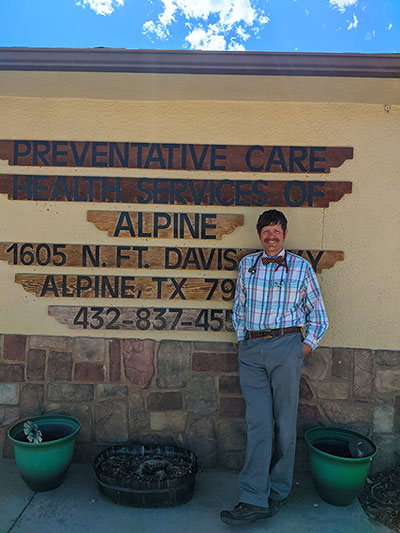DFMCH Alumni Share Experiences from Rural Texas

John Ray, MD, outside his clinic in Alpine, Texas.
When John and Katie Ray met at the University of Texas Medical Branch, they discovered a shared interest in serving rural communities. Both fell in love with small-town life during medical school rotations. Katie Ray, MD (Madison ’13), grew up in a Houston suburb but had the opportunity to experience a more rural setting in Galveston, Texas. “It was small enough that I could get a good sense of what life in a smaller place was like,” shared Katie. “Shopping at stores where you know the owners, seeing friends around town—I love that feeling.” John Ray, MD (Madison ’12), had an opportunity to explore the beauty of Far West Texas where he embraced the rugged terrain and the toughness and independence of the people. They would eventually settle in Alpine, Texas, population 6,006, but not before completing their residency training at the UW Department of Family Medicine and Community Health; an experience both credit with preparing them for the challenges of rural practice.
Residency
Katie trained at the Wingra Family Medical Center in Madison and is grateful for the experience she had working for a Federally Qualified Health Center (FQHC). She currently practices family medicine and obstetrics through an FQHC, Preventative Care Health Services (PCHS), at clinics in Marfa, Alpine, and Presidio. “We have a small staff, and we all wear many hats. I was familiar with the logistics of how to get the resources we need through an FQHC because of my experience at Wingra,” said Katie.
At the UW Health Clinic in Belleville, John trained in a more rural setting and is appreciative of the phenomenal faculty he worked with at the clinic. “Kathy Oriel suggested the Belleville Clinic, and I’ll always be grateful for that experience and the amazing mentors I trained with,” added John. Dr. Oriel, now in private practice, was the director of the DFMCH Family Medicine Residency Program for nine years. John currently practices family medicine in PCHS clinics caring for patients across two of the largest counties in Texas, Presidio and Brewster. It’s a part of the country where the nearest Walmart is over 70 miles away, and patients must rely on weekly prescription deliveries instead of local pharmacies. Together the counties cover over 10,000 square miles with a total population of around 16,000. “That’s a lot of miles to cover to get patients the care they need,” he said. In addition to the excellent training they received in the clinic settings, John and Katie were impressed with the amount of time they both received training in the ICU and the breadth of patients they encountered. “We both chose this residency program because we wanted to have a lot of ICU time,” said Katie. “If our plan was to work in a rural area, we needed to know how to take care of really sick people when the nearest hospital could be hours away. Training at UW gave us the confidence to take care of critically ill patients with limited resources,” she added.
A Global Pandemic
It wasn’t long before planning for the care of the critically ill tested the husband and wife team as the COVID-19 pandemic spread across the US. As hot spots emerged in Washington and New York, Katie and John met with physicians across their counties preparing for the worst-case scenario. With the nearest large hospital, Big Bend Regional Medical Center, almost 4 hours away for some patients, planning was crucial. “It was terrifying at the start as I imagine it was for most people,” said Katie. “I didn’t worry about the illness as much as I feared overwhelming our capacity and our resources. We didn’t want to fail the community by coming up short or having to ration ventilators.” Plans included regularly rotating the few available physicians throughout the area to prevent them from getting sick. The money would be dealt with later. “We weren’t sure what would happen financially, but we needed to take care of our patients,” added Katie. Thankfully, the isolated lifestyle of the Big Bend Region of Texas likely slowed the spread. The first COVID-19 case in the area wasn’t reported until June 2020. A manageable spike followed in early July with the largest one descending in the fall of 2020, making Alpine the subject of a New York Times article, “Small Town, No Hospital: COVID-19 Is Overwhelming Rural West Texas.” John and Katie were both featured in the article but are thankful the ominous predictions of possibly running out of beds for their escalating COVID patients never came to pass. The carefully constructed emergency plan was not needed. “We don’t have a lot of staff to begin with and couldn’t afford to have them in quarantine,” said John. With proper precautions in place, their team remained healthy.
The Hope of Spring
Cases declined through the winter months and vaccines became readily available. They are currently monitoring 10-20 active cases at one time, down from over 1,100 cases just 6 months ago. Their service area also boasts one of the highest vaccine rates in the country. The initial 500 vaccine doses received, a lot for such a sparsely populated area, allowed distribution to the general population to start in February, a month that also marked a different kind of milestone for the Rays; they also welcomed a baby girl to their family. As Katie finishes her maternity leave, she and John both look forward to seeing fewer COVID-19 cases as they get back to helping patients with routine checkups and the typical challenges that accompany life on one of the final frontiers.
Published: May 2021
